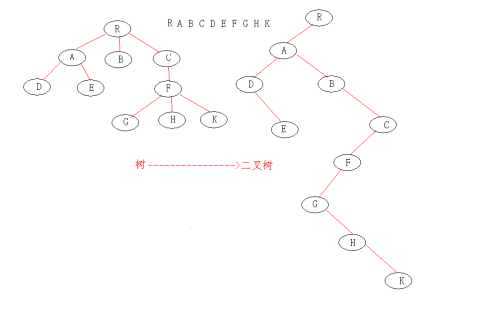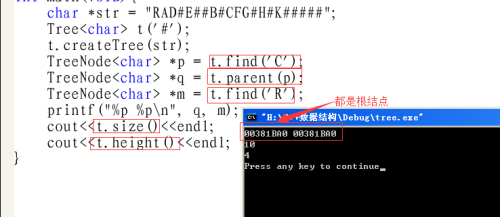1、树、森林为什么向二叉树转换?
因为在实际的处理问题中,大多数情况都是一对多,就像树、森林这样的数据结构!
而对于二叉树我们已经很熟悉了,所以就转向我们所熟悉的结构,比较容易处理。
2、孩子兄弟树的方法
把握
左孩子右兄弟
的原则:
(1)、树与二叉树的转换
i>以树的根结点为二叉树的根节点;
ii>左孩
子指针指向该根节点的第一个子结点;
iii>右
孩子指针指向"兄弟结点"。
(2)、二叉树表示森林
i>二叉树的根结点是森林中第一棵树的根结点;
ii>根结点的右孩
子为森林中其它树的根结点。
3、图形表示法
 4、树的创建----->转化二叉树
应具有的存储结构:树结点和树。
4、树的创建----->转化二叉树
应具有的存储结构:树结点和树。

 推荐阅读:
从零开始学习数据结构-->入门篇
从零开始学习数据结构-->链表
从零开始学习数据结构-->线性表
从零开始学习数据结构-->栈
从零开始学习数据结构-->队列
从零开始学习数据结构-->矩阵+串
从零开始学习数据结构-->哈希表
从零开始学习数据结构-->散列桶
从零开始学习数据结构-->二叉树
推荐阅读:
从零开始学习数据结构-->入门篇
从零开始学习数据结构-->链表
从零开始学习数据结构-->线性表
从零开始学习数据结构-->栈
从零开始学习数据结构-->队列
从零开始学习数据结构-->矩阵+串
从零开始学习数据结构-->哈希表
从零开始学习数据结构-->散列桶
从零开始学习数据结构-->二叉树
 4、树的创建----->转化二叉树
应具有的存储结构:树结点和树。
4、树的创建----->转化二叉树
应具有的存储结构:树结点和树。
1template<typename Type>
2class TreeNode{
3 friend class Tree;
4public:
5 TreeNode() : data(Type()), firstChild(NULL), nextSibling(NULL){}
6 TreeNode(Type d, TreeNode *first = NULL, TreeNode *next = NULL) :
7 data(d), firstChild(first), nextSibling(next){}
8 ~TreeNode(){}
9private:
10 Type data;
11 TreeNode *firstChild; //第一个孩子
12 TreeNode *nextSibling; //下一个兄弟
13};
14
15template<typename Type>
16class Tree{
17public:
18 Tree() : root(NULL){}
19 Tree(Type ref) : root(NULL), refval(ref){}
20 ~Tree(){}
21private:
22 TreeNode *root;23 Type refval; //'#'24}; 1public:
2 void createTree(const char *str); //创建树
3 int size()const; //求树的结点个数
4 int height()const; //求树高
5 TreeNode* root_1()const; //返回根结点 6 bool isEmpty()const; //判树空 7 TreeNode *firstChild()const; //返回第一个孩子结点 8 TreeNode *nextSibling()const; //返回第一个兄弟结点 9 TreeNode* find(Type key)const; //查找当前结点10 TreeNode* parent(TreeNode *cur)const; //查找当前结点的父 1 int height(TreeNode *t)const{
2 TreeNode *p; 3 int m; 4 int max = 0; 5 6 if(t == NULL){ 7 return 0; //空树,高0 8 }else if(t->firstChild == NULL){ 9 return 1; //只有根,为110 }else{11 p = t->firstChild; //先为第一个孩子12 while(p != NULL){13 m = height(p); //求高14 if(max 15 max = m; //遍历所有的分支,每次求最高的16 }17 p = p->nextSibling; //每次往右分支走,但还是求的左边树高;18 }19 return max+1; //返回时加上根的高度20 }21 } 1 TreeNode* parent(TreeNode *t, TreeNode *cur)const{ 2 if(t == NULL || cur == NULL || t == cur){ //父为NULL 3 return NULL; 4 } 5 TreeNode *p = t->firstChild; 6 while(p != NULL && p != cur){ 7 TreeNode *tmp = parent(p, cur); //递归查找其父结点,将找的结果给了tmp; 8 if(tmp != NULL){ 9 return tmp;10 }11 p = p->nextSibling; //在往右找12 }13 if(p != NULL && p == cur){14 return t; //找到了15 }else{16 return NULL;17 }18 } 1#ifndef _TREE_H_
2#define _TREE_H_
3
4#include
5using namespace std;
6
7template<typename Type>
8class Tree;
9
10template<typename Type>
11class TreeNode{
12 friend class Tree;
13public:
14 TreeNode() : data(Type()), firstChild(NULL), nextSibling(NULL){}
15 TreeNode(Type d, TreeNode *first = NULL, TreeNode *next = NULL) :
16 data(d), firstChild(first), nextSibling(next){}
17 ~TreeNode(){}
18private:
19 Type data;
20 TreeNode *firstChild;
21 TreeNode *nextSibling;
22};
23
24template<typename Type>
25class Tree{
26public:
27 Tree() : root(NULL){}
28 Tree(Type ref) : root(NULL), refval(ref){}
29 ~Tree(){}
30public:
31 void createTree(const char *str){
32 createTree(root, str);
33 }
34 int size()const{
35 return size(root);
36 }
37 int height()const{
38 return height(root);
39 }
40 TreeNode* root_1()const{ 41 return root; 42 } 43 bool isEmpty()const{ 44 return root == NULL; 45 } 46 TreeNode *firstChild()const{ 47 if(root != NULL){ 48 return root->firstChild; 49 } 50 return NULL; 51 } 52 TreeNode *nextSibling()const{ 53 if(root != NULL){ 54 return root->nextSibling; 55 } 56 return NULL; 57 } 58 TreeNode* find(const Type &key)const{ 59 return find(root, key); 60 } 61 TreeNode* parent(TreeNode *cur)const{ 62 return parent(root, cur); 63 } 64protected: 65 void createTree(TreeNode *&t, const char *&str){ 66 if(*str == refval){ 67 t = NULL; 68 }else{ 69 t = new TreeNode(*str); 70 createTree(t->firstChild, ++str); 71 createTree(t->nextSibling, ++str); 72 } 73 } 74 int size(TreeNode *t)const{ 75 if(t == NULL){ 76 return 0; 77 } 78 return size(t->firstChild) + size(t->nextSibling) + 1; 79 } 80 TreeNode* parent(TreeNode *t, TreeNode *cur)const{ 81 if(t == NULL || cur == NULL || t == cur){ 82 return NULL; 83 } 84 TreeNode *p = t->firstChild; 85 while(p != NULL && p != cur){ 86 TreeNode *tmp = parent(p, cur); 87 if(tmp != NULL){ 88 return tmp; 89 } 90 p = p->nextSibling; 91 } 92 if(p != NULL && p == cur){ 93 return t; 94 }else{ 95 return NULL; 96 } 97 } 98 TreeNode* find(TreeNode *t, const Type &key)const{ 99 if(t == NULL){100 return NULL;101 }102 if(t->data == key){103 return t;104 }105 TreeNode* p = find(t->firstChild, key);106 if(p != NULL){107 return p;108 }109 return find(t->nextSibling, key);110 }111 int height(TreeNode *t)const{112 TreeNode *p;113 int m;114 int max = 0;115116 if(t == NULL){117 return 0;118 }else if(t->firstChild == NULL){119 return 1;120 }else{121 p = t->firstChild;122 while(p != NULL){123 m = height(p);124 if(max 125 max = m;126 }127 p = p->nextSibling;128 }129 return max+1;130 }131 }132private:133 TreeNode *root;134 Type refval; //'#'135};136137#endif
1#include"tree.h"
2
3int main(void){
4 char *str = "RAD#E##B#CFG#H#K#####"; //先根序的二叉树序列;
5 Tree<char> t('#');
6 t.createTree(str);
7 TreeNode<char> *p = t.find('C');
8 TreeNode<char> *q = t.parent(p);
9 TreeNode<char> *m = t.find('R');
10 printf("%p %p\n", q, m);
11 cout<endl;12 cout<endl;1314 return 0;15} 推荐阅读:
从零开始学习数据结构-->入门篇
从零开始学习数据结构-->链表
从零开始学习数据结构-->线性表
从零开始学习数据结构-->栈
从零开始学习数据结构-->队列
从零开始学习数据结构-->矩阵+串
从零开始学习数据结构-->哈希表
从零开始学习数据结构-->散列桶
从零开始学习数据结构-->二叉树
推荐阅读:
从零开始学习数据结构-->入门篇
从零开始学习数据结构-->链表
从零开始学习数据结构-->线性表
从零开始学习数据结构-->栈
从零开始学习数据结构-->队列
从零开始学习数据结构-->矩阵+串
从零开始学习数据结构-->哈希表
从零开始学习数据结构-->散列桶
从零开始学习数据结构-->二叉树
从零开始学习数据结构-->二叉树方法实现
从零开始学习数据结构-->线索二叉树




















 1726
1726











 被折叠的 条评论
为什么被折叠?
被折叠的 条评论
为什么被折叠?








